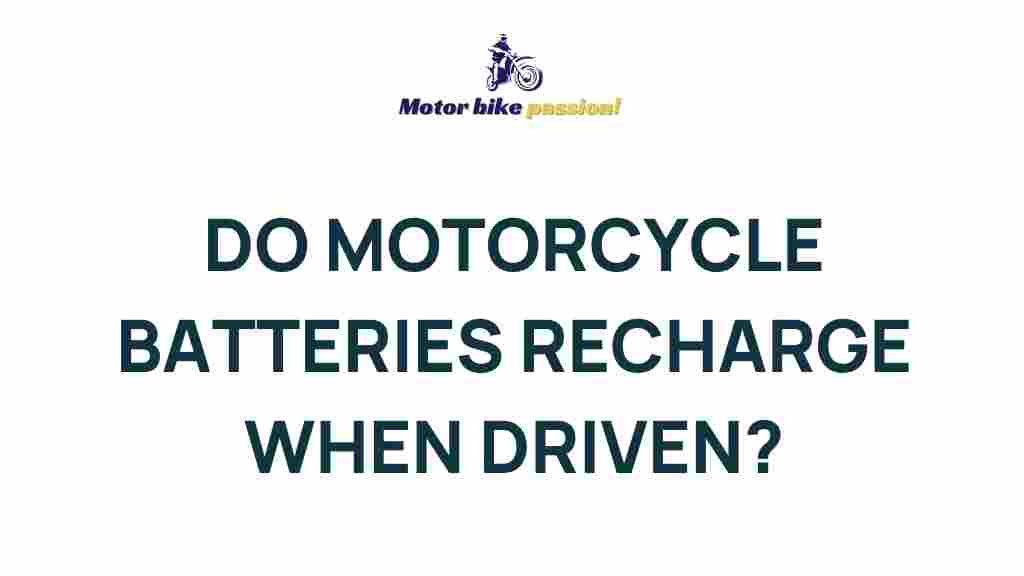Unveiling the Mysteries of Motorcycle Battery Recharging
Motorcycles are not just a mode of transportation; they are a way of life. Riding a motorcycle brings a sense of freedom and adventure that is hard to match. However, to keep your motorcycle in peak condition, understanding the intricacies of motorcycle batteries and their recharge process is crucial. In this article, we will explore how to effectively maintain your motorcycle batteries, recharge them properly, and ensure your bike is always ready for the road.
Understanding Motorcycle Batteries
Motorcycle batteries are the heart of your bike’s electrical system. They provide the initial power needed to start the engine and supply energy for the lights, signals, and other essential components. Most motorcycles use either lead-acid or lithium-ion batteries, each with its own set of characteristics and maintenance needs. Understanding these differences is key to effective battery management.
- Lead-Acid Batteries: These are the most common type of motorcycle batteries. They are reliable and cost-effective but require regular maintenance.
- Lithium-Ion Batteries: These batteries are lighter and have a higher energy density, allowing for longer rides without the weight. However, they can be more expensive.
The Importance of Recharging
Regular recharging of your motorcycle batteries is essential to maintaining their efficiency and longevity. A fully charged battery ensures that your motorcycle starts reliably every time you hit the ignition. Additionally, a well-maintained battery contributes to the overall performance of your motorcycle while reducing the risk of breakdowns.
How to Recharge Your Motorcycle Battery
Recharging your motorcycle battery can be a straightforward process if you follow the correct steps. Here’s a step-by-step guide to help you recharge your motorcycle battery safely and efficiently:
Step 1: Gather Your Supplies
Before you begin, make sure you have the following items:
- Battery charger
- Wrenches (if needed to disconnect the battery)
- Safety goggles and gloves
- Multimeter (optional, for checking battery voltage)
Step 2: Safety First
Always prioritize safety when working with batteries. Wear safety goggles and gloves to protect yourself from any potential acid spills or sparks.
Step 3: Locate the Battery
Find the motorcycle battery, usually located under the seat or side panel. Refer to your motorcycle’s manual if you’re unsure where it is.
Step 4: Disconnect the Battery (if necessary)
If your motorcycle battery needs to be removed for charging, carefully disconnect the negative (-) terminal first, followed by the positive (+) terminal. This prevents any electrical shorts.
Step 5: Connect the Charger
Using a battery charger, connect the positive (+) lead to the positive terminal and the negative (-) lead to the negative terminal. Make sure the charger is turned off before making these connections.
Step 6: Set the Charger
Set the charger to the appropriate voltage and current for your battery type. Most chargers have settings for both lead-acid and lithium-ion batteries. Consult your charger’s manual for guidance.
Step 7: Start Charging
Turn on the charger and monitor the charging process. Depending on the battery’s state of charge, this could take anywhere from a couple of hours to overnight.
Step 8: Disconnect the Charger
Once fully charged, turn off the charger and disconnect the leads in reverse order: negative (-) first, then positive (+).
Step 9: Reinstall the Battery
If you removed the battery, carefully reinstall it by connecting the positive (+) terminal first, followed by the negative (-) terminal. Ensure all connections are secure.
Maintenance Tips for Motorcycle Batteries
To keep your motorcycle batteries in top condition, follow these maintenance tips:
- Regular Checks: Inspect your battery monthly for corrosion, loose connections, and overall condition.
- Keep It Clean: Clean the terminals and cables with a mixture of baking soda and water to prevent corrosion.
- Avoid Deep Discharge: Try not to let your battery discharge below 12.4 volts. Deep discharges can shorten battery life.
- Use a Smart Charger: Investing in a smart charger can help maintain your battery without overcharging.
Troubleshooting Common Battery Issues
Even with proper maintenance, you might encounter issues with your motorcycle battery. Here are some common problems and their solutions:
Problem 1: Motorcycle Won’t Start
If your motorcycle won’t start, check the following:
- Ensure the battery is fully charged.
- Check for loose or corroded connections.
- Test the battery voltage with a multimeter; it should read around 12.6 volts.
Problem 2: Battery Drains Quickly
Fast drainage can be caused by:
- Leaving lights or accessories on when the motorcycle is off.
- A faulty charging system that fails to recharge the battery while driving.
- Old or damaged battery that needs replacement.
Problem 3: Corrosion Buildup
If you notice white or green corrosion around the terminals, do the following:
- Disconnect the battery and clean the terminals with a mixture of baking soda and water.
- Dry the terminals and apply a thin layer of petroleum jelly to prevent future corrosion.
Conclusion
Understanding how to recharge your motorcycle batteries effectively and maintaining them properly is essential for any motorcycle enthusiast. By following the steps outlined in this article, you can ensure your motorcycle remains powered and ready to hit the road. Regular maintenance and awareness of potential issues will enhance your riding experience and prolong the life of your motorcycle batteries.
For more detailed information on motorcycle maintenance, you can check out this comprehensive guide. If you’re looking for quality batteries and accessories, consider visiting this trusted supplier for your needs.
This article is in the category Maintenance Tips and created by MotorBikePassion Team
